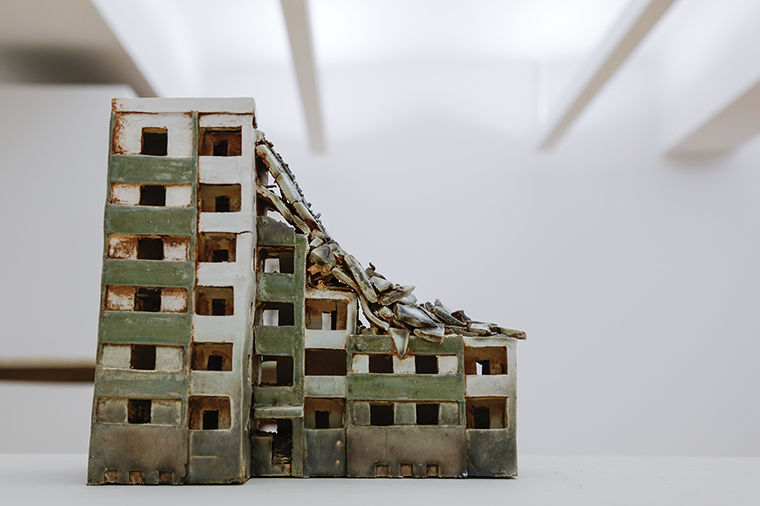Exhibit explores effects of warfare and human behavior
Alison Ruttan used ceramic structures and photography to explore warfare’s destruction and effects on human behavior in her new exhibit at the Chicago Cultural Center, 78 E. Washington St.
February 2, 2015
A new exhibit at the Chicago Cultural Center, 78 E. Washington St., highlights the effects of war engendered destruction and human behavior.
The exhibition, “When All You Have Is a Hammer, Everything Looks Like a Nail,” opened Jan. 24 and will run through April 26 at the Michigan Galleries, showing three separate pieces created by artist Alison Ruttan.
Ruttan, an interdisciplinary artist based in Chicago, focuses on exploring human nature and behavior themes through photography and videography. For the exhibit in the Cultural Center, Ruttan said she combined photos and ceramic sculptures to convey aggression and wartime destruction.
The City of Chicago’s Department of Cultural Affairs and Special Events asked Ruttan to create a show that spanned through three galleries, she said.
“This exhibit is two years worth of work,” Ruttan said. “The Cultural Center works on long-term projects, so I knew I was going to have this project two years ago, and it was designed specifically for [the Michigan Galleries].”
“A Bad Idea Seems Good Again,” the first showcased gallery, is made of a series of ceramic buildings based on sites of violent conflict from around the world. Each building was created separately and destroyed differently using weights and a BB gun. The ceramic structures purposely lack detail and color—an artistic choice meant to give a haunting feel to the demolished buildings.
The second gallery holds a selection of photographs from Ruttan’s photo- and video-based work, “The Four Year War At Gombe.” Ruttan said the series is based on English primatologist Jane Goodall’s studies about chimpanzee behavior and strategic thinking. With the help of friends and neighbors, Ruttan’s work tells the story of a broken primate community through happiness and the escalation of nine murders that occurred at Gombe Stream National Park in Tanzania between 1973 and 1977.
The third gallery, “Line In The Sand,” references the highway of death, a highway on which cars exploded or completely melted due to bombing during the Gulf War in Kuwait and Iraq. From the individual molding of the ceramic cars to the vehicles that were pushed into the sand surrounding the highway, viewers can see the immense amount of physicality that went into the work.
Ruttan said her three works in the show come as a result of wanting to look at traces of human behavior and the cyclical nature of war and aggression.
“This work comes out of years of looking at war on the TV and being affected by it,” Ruttan said. “I reached a point where I just couldn’t ignore it because it had been going on for so long.”
Creating the ceramic-based exhibits “A Bad Idea Seems Good Again” and “Line In The Sand” is not the norm for Ruttan. She said using clay creates a sense of intimacy that draws the viewers closer than photograph or a video might.
“[The buildings] were drawn from cement construction and modern buildings, particularly international style slab construction,” Ruttan said. “[Cement] breaks apart very much the same way clay does. These are built completely whole and then destroyed.”
Daniel Schulman, director of visual art for the Department of Cultural Affairs, programmed and curated Ruttan’s show at the Cultural Center.
“[Ruttan’s] extraordinary work, which has been widely praised by critics, curators and her peers, merits a larger public platform and exposure,” Schulman said in an email.
Ruttan said the pieces in this show differ from her previous works because the new pieces reference more issues relating to social politics.
“I used to have more humor in my work,” Ruttan said. “If you look at [‘The Four Year War At Gombe’], you’ll see some of that still there, but with some of these war studies in ceramics, what I’m starting with is so devastating that it has just demanded a different way of addressing it through the material nature of what I’m making.”
Ruttan said she wants viewers to question the topics her pieces explore in addition to using the exhibit as a space for self-reflection.
“[The exhibit is] very much setting up something that’s a private moment for the viewer to come to their own conclusions about their lives,” Ruttan said.








